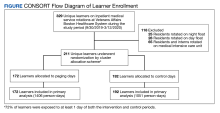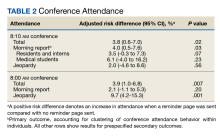Results
Over the study period, 329 unique learners rotated on inpatient medical services at the VABHS and 211 were eligible to attend 85 morning report conferences and 22 Jeopardy conferences (Figure). Outcomes data were available for 100% of eligible participants. Forty-seven (55%) of the morning report conferences occurred during the intervention period (Table 1).
Morning report attendance observed at 8:10 am was 5.5% higher during the intervention period compared with the control period (49.9% vs 44.4%, P = .007). Accounting for clustering within individuals, the unadjusted risk difference in morning report attendance associated with sending a reminder page was 3.6% (95% CI, 0.09%-7.2%; P = .04) compared with no reminder page. When adding date and team to our model, the adjusted risk difference in conference attendance increased to 4.0% (95% CI, 0.5%-7.6%; P = .03) (Table 2). Results were similar in a sensitivity analysis using a multilevel generalized linear model accounting for clustering by both individual and team (adjusted risk difference, 4.0% [95% CI, 0.4%-7.6%; P = .03]).
On-time attendance was lower than at 8:10 am in both groups, with no difference in the observed attendance at 8:00 am between the control and intervention groups (22.4% vs 25.0%, P = .14). Regarding Jeopardy-like conferences, on-time attendance differed between the control and intervention groups at 8:00 am (15.3% vs 23.6%, P = .01), but not at 8:10 am (42.9% vs 42.8%, P > .99). We found no evidence of an interaction between receipt of a reminder page and learner type (student vs house staff, P = .33).
To estimate the impact of rotating on teams with lighter clinical workloads on the association between receipt of a reminder page and conference attendance, we repeated our primary analysis with a test of interaction between team assignment and the intervention, which was not significant (P = .90). To estimate the impact of morning workload on the association between receipt of a reminder page and conference attendance, we performed a subgroup analysis limited to learners rotating on teams eligible to receive overnight admissions and included the number of overnight admissions as a covariate in our regression model. A test of interaction between the intervention and the number of overnight admissions on conference attendance was not significant (P = .73).
In a subgroup analysis limited to learners on teams eligible to receive overnight admissions and controlling for the number of overnight admissions (a proxy for morning workload), no significant interaction between the intervention and admissions was observed. We also assessed for interaction between learner type and receipt of a reminder page on conference attendance and found no evidence of such an effect.
Discussion
Among a diverse population of learners from multiple academic institutions rotating at a single, large, urban VA medical center, a nudge strategy of sending a reminder text page before morning report conferences was associated with a 4.0% absolute increase in attendance measured 10 minutes after the conference started compared with not sending a reminder page. Overall, only one-quarter of learners attended the morning report at the start at 8:00 am, with no difference in on-time attendance between the intervention and control periods.
We designed our analysis to overcome several limitations of prior studies on the effect of reminder text pages on conference attendance. First, to account for differences in conference attendance behavior of individual learners, we used a generalized estimating equation model that allowed clustering of outcomes by individual. Second, we controlled for the date to account for secular trends in conference attendance over the academic year. Finally, we controlled for the team to account for the possibility that the conference attendance behavior of one learner on a team influences the behavior of other learners on the same team.
We also evaluated the effect of a reminder page on attendance at a weekly Jeopardy conference. Interestingly, reminder pages seemed to increase on-time Jeopardy attendance, although this effect was no longer statistically significant at 8:10 am. A possible explanation for this is that the fun and collegial nature of Jeopardy conferences entices learners to attend independent of a reminder page.
We also assessed the interaction between sending a reminder page and learner type and its effect on conference attendance and found no evidence to support such an effect. Because medical students do not receive reminder pages, their conference attendance behavior can be thought of as indicative of clustering within teams. Though there was no evidence of a significant interaction, given the small number of students, our study may be underpowered to find a benefit for this group.
The results of this study differ from Smith and colleagues, who found that reminder pages had no overall effect on conference attendance for fellows; however, no sample size justification was provided in that study, making it difficult to evaluate the likelihood of a false-negative finding.7 Our study differs in several ways: the timing of the reminder page (5 minutes vs 30 minutes prior to the conference), the method by which attendance was recorded (by an independent observer vs learner sign-in), and the time that attendance was recorded (2 prespecified times vs continuously). As far as we know, our study is the first to evaluate the nudge effect of reminder text pages on internal medicine resident attendance at conferences, with attendance taken by an observer.



